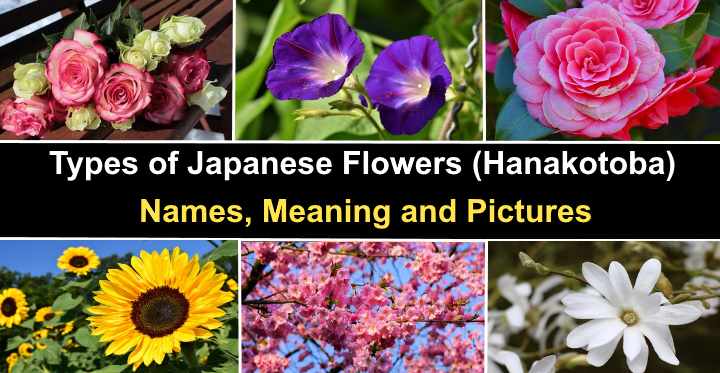The language of Hanakotoba reflects the importance of flowers in Japanese culture. The meanings of most flowers in Japan are unique. Sakura (cherry blossom), Tsubaki (camellia), Ume (flowering apricot tree), Sumire (violet), and Sakurasou (Japanese primrose) are some of the most exquisite Japanese flowers. Flowers contain hidden messages and may convey strong messages, according to the Hanakotoba (Japanese “language of flowers”).
Of course, in many cultures, flowers have distinct connotations. Red flowers, for example, are often associated with love, whereas white flowers may denote a fresh start. Dark crimson roses, on the other hand, are associated with sadness. Flowers have a much stronger, more important connotation in Japanese culture.
The Japanese term for the flower language, Hanakotoba, is explained in this article. You’ll discover the code, symbolism, and meaning of some of Japan’s most gorgeous flowers.
What Is Hanakotoba?
The Japanese language of flowers, Hanakotoba, is unique because it allows you to express your intentions and emotions. Flowers have their own unique meanings and sentiments that cannot be conveyed in any other way. Hanakotoba is one of the world’s most distinctive languages because each blossom has its own meaning and code.
Flowers may be used in Hanakotoba to communicate your deepest emotions and intentions without saying anything. The colors, form, height, and presence of thorns all transmit distinct feelings through the flowers. One of the oldest methods to express sentiments via flowers, according to folklore, is Hanakotoba.
Japanese Flowers (Hanakotoba) with their Name and Meaning
Let’s look at some of Japan’s most popular flowers that are linked with Hanakotoba in further detail. The special meaning of each flower in Hanakotoba will be revealed to you.
Tsubaki – Camellia (Camellia japonica)

In Japanese Hanakotoba, the red camellia blossom represents love. Camellia may mean supreme love, humility, or discretion in the Japenese language of flowers (Hanakotoba). Tsubaki has various connotations depending on the color of the camellia. The yellow camellia denotes yearning, while the red camellia denotes love. White camellia denotes waiting.
The rose of winter is a term used to describe Japanese camellia (tsubaki). Camellia japonica, a 20-foot-tall flowering plant, is a popular landscape plant. The showy blooms, which resemble peony blooms, may be solitary, semi-double, or double. The large blooms come in a variety of colors, including soft pink and dark crimson red. USDA zones 6 through 10 are suitable for growing Japanese camellias.
Sakura – Cherry blossom (Prunus serrulata)
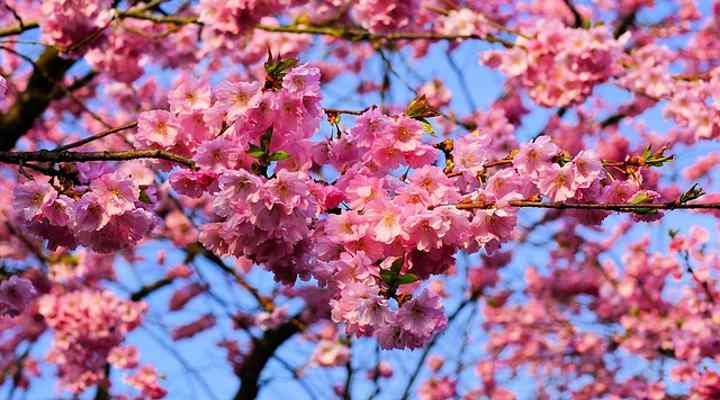
Sakura, or cherry blossoms, are Japan’s national flower. They represent the splendor of the heart as well as accomplishment. As the cherry trees bloom in the spring, their light pink and white blossoms cover them. The showy, delicate blossoms hang down in clusters, creating spectacular displays that have made the plant famous throughout Japan.
Sakura is a Japanese cherry blossom tree that has become synonymous with the country. Japan’s national flower is Sakura. Sakura matsuri are Japanese festivals devoted to the lovely Sakura blossoms. Cherry blossom trees come in a variety of shapes and sizes, with Prunus serrulata being the most common. Depending on the cultivar, cherry blossom trees range from 8 to 40 feet (2.5 to 12 meters) tall.
Sakurasou – Japanese primrose (Primula sieboldii)
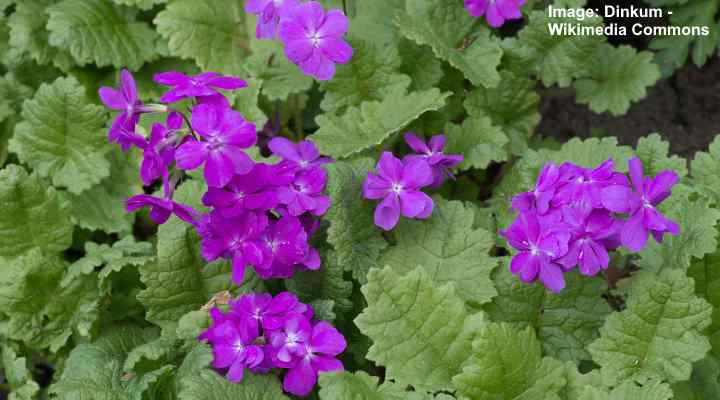
The Hanakotoba word for “long-lasting love” is Japanese primrose flower (Sakurasou). Sakurasou is a Japanese primrose that has magenta or purple blooms that signify long-term love in Hanakotoba. The flower’s resemblance to Sakura inspired the Japanese name Sakurasou. In the spring, the five-petalled magenta daisy-like blooms bloom abundantly. In Japan, the primrose is a popular decorative shrub.
Geisha girl, Madam butterfly, cherry blossom primrose, and snowflake are some of the other names for Sakurasou. The primrose, which grows to be 18″ (45 cm) tall, is a perennial blooming plant native to Japan. Mixed beds and flowering borders are the optimum growing conditions for this lovely plant. USDA zones 4 through 8 grow in partial sun.
Roses (Rosa)
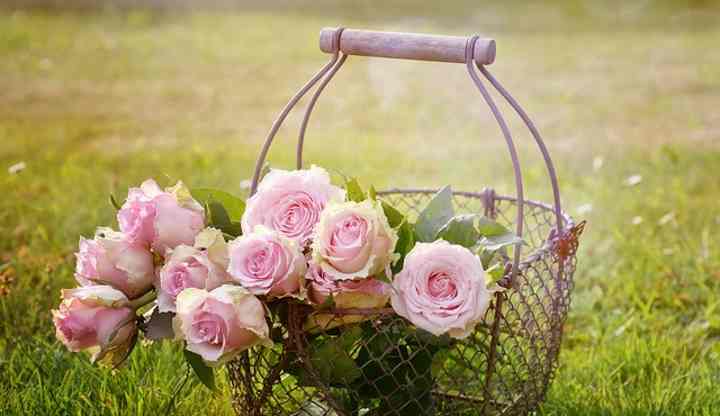
In Hanakotoba, pink roses (Momirobara) signify trust, pleasure, or bravery. When someone wants to communicate their deepest emotions, roses are popular floral gifts in Japanese gardens. The shapes, sizes, and colors of rose flowers may vary. The meanings of rose hues are shown below in the “language of flowers.”
Akaibara (Red Rose)
In Western and Asian cultures, the red rose is a symbol of passionate love. Love, passion, and deep affection are all conveyed through giving someone a bunch of red roses.
Shiroibara (White Rose)
Devotion, innocence, and quiet are all expressed with the Shirobara or white rose.
Kiiroibara (Yellow Rose)
The term jealousy is represented by Hanakotoba, Kiiroibara, or the yellow rose.
Momirobara (Pink Rose)
Momirobara is a Japanese word that expresses confidence, happiness, and trust in someone. Your emotions for someone without a romantic relationship may be expressed with a bouquet of pink roses.
Ume – Apricot Tree Blossom (Prunus mume)

In Hanakotoba, the blossoming apricot tree is referred to as Ume, which means fidelity, pure heart, and elegance. When Ume is in full bloom, it is a spectacular sight, similar to Sakura. The light pink or white flowers emit a delicate honey floral fragrance that permeates parks.
Japanese plum or Japanese apricot are two common names for Prunus mume. Apricot trees flower with beautiful showy blooms that are 1 inch (2.5 cm) in diameter and range in height from 13 to 33 feet (4 to 10 m). Flowers may be pink, white, or red depending on the apricot tree variety.
Himawari – Sunflower (Helianthus)

Due to its huge yellow blooms that signify devotion, lengthivity, and adoration in Hanakotoba, the sunflower is a famous Japanese flower emblemizing devotion, lengthivity. The Himawari Matsuri event, which is devoted to the huge yellow flowers, takes place every year in Japan.
Depending on the climate, sunflowers may be annuals or perennials. The enormous daisy-like blooms may reach 10 feet (3 meters) in height, and the tall, sun-loving blooms might reach up to 10 feet (3 meters). In zones 2 through 11, sunflowers are hardy.
Asagao – Morning Glory (Ipomoea)

Morning Glory in English refers to short or long-term love (Asago in Hanakotoba). In the morning, trumpet-like blooms last for a short time, and by late afternoon, they are gone. Asagao symbolizes short love in Japanese culture because of each flower’s brief blooming period.
The plant can also symbolize a long-term connection of love because it blooms continuously from spring to autumn. The twining evergreen vine Morning Glory (or Asagao) has vigorous growth. Blue, white, purple, white, and deep red clusters of flowers appear on the vines’ velvety heart-shaped leaves. Only zones 9 and above are suitable for Morning Glory.
Momo – Peach Tree Blossom (Prunus persica)

The flowering peach tree Momo represents a spectacular personality in Japanese culture. In Japan, where it is thought that they protect against evil spirits, peach blossoms are linked with Hina Matsuri or Girl’s Day. Late March and early April are peak times for ornamental peach trees, also known as Momo.
In the spring, clusters of ruffled petals cover the tree, giving it a showy appearance. Since their tiny fruit is inedible, ornamental peach trees are cultivated for their blossoms.
Kiku (Chrysanthemum)

Chrysanthemum is a symbol of the imperial family in Japan, and its beautiful flowers are revered. Kiku is linked to aristocracy, longevity, trust, and purity in the Hanakotoba. Chrysanthemum flowers are associated with the Japanese imperial family and emperors because of their symbolism. Kiku flowers are also seen on several kimonos.
Chrysanthemums are huge blooms that bloom in the autumn and are quite stunning. Chrysanthemum flowers come in a variety of colors, including red, coral, yellow, pink, and white. Chrysanthemum blooms may be pompoms or star-shaped blooms that resemble daisies.
Kosumosu (Cosmos)

Kosumosu is a common Japanese flower that signifies affection and neatness in Hanakotoba. At the end of thin stems that grow to be around 6 feet (1.8 meters) tall, tiny daisy-like blooms sit. Kosumosu may be grown in zones 2 through 11 and is a hardy annual. Bloom till the fall, the blooms bloom all summer.
Kinmokusei – Sweet Osmanthus (Osmanthus aurantiaca)

The orange flowers of Kinmokusei represent truth and nobility, as well as trustworthiness in Hanakotoba. This fragrant evergreen shrubby bush has clusters of orange flowers and is known as sweet Osmanthus, sweet olive, or tea olive.
White or yellow blooms may be found on some Kinmokusei species. Korea, China, Japan, and Southeast Asia are all home to Kinmokusei. Kinmokusei is the official “city tree” of several Japanese cities.
Magunoria (Magnolia)

In Japanese culture, star magnolia is the most popular magnolia cultivar because of its brilliant white blossoms. Magunoria is also known as the lovely magnolia bush in the West. Magnolias are small trees or huge shrubs with evergreen or deciduous foliage.
Magnolia species produce tulip-like blooms that can be up to 12 inches (30 cm) wide. The most common magnolia variety is the Star magnolia (Magnolia stellata), also known as the Japanese Shidekobushi. The blossoms have a star-like shape and are white.
Renge – Lotus (Nelumbo nucifera)

Renge, or lotus flowers, signify love, chastity, or purity when used in Hanakotoba. Lotus flowers (Renge) can be added to floral arrangements in Japan to show affection, chastity, and purity when you’re separated from someone you adore. The gorgeous underwater pink blossom sits on ponds and water gardens, floating on the surface.
Exotic lotus blooms bloom on the pond’s bed, where they emerge from rhizomes. The floating leaves are up to 24” (60 cm) wide, and the spectacular tropical-looking blooms may reach 12″ (30 cm) in diameter.
Haibīsukasu (Hibiscus)
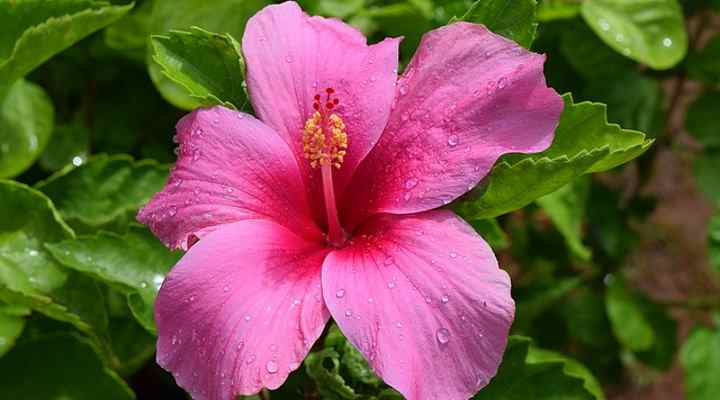
The most common hibiscus plant in Japan is Chinese hibiscus (Hibiscus rosa-sinensis), with delicate red or pink papery petals. Someone who is kind rather than powerful or respected might be represented by a hibiscus flower on their clothing. Hibiscus rosa-sinensis, commonly known as tropical Chinese hibiscus, is the most popular hibiscus plant in Japan.
Only USDA zones 9 through 12 support tropical hibiscus plants. Zone 5 through 9 is home to Hardy hibiscus species like the Rose of Sharon. For any sunny outdoor to enjoy tropical flowers all summer long, Hibiscus trees and shrubs are ideal flowering plants.
Tenjikubotan (Dahlia)
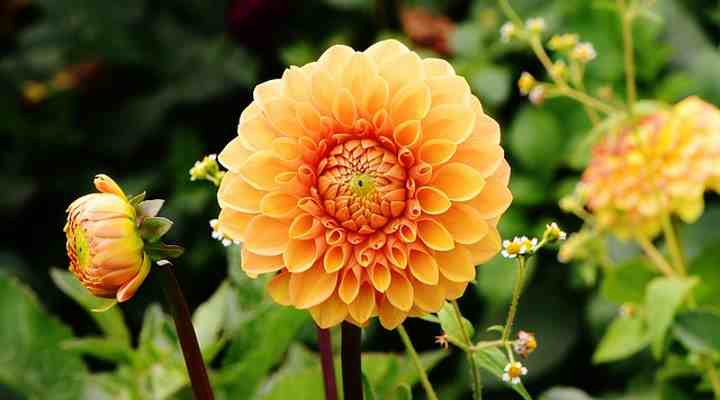
Tenjikubotan, a fitting symbol of the spectacular dahlia flowers, means “of good taste” in Japanese culture. Large bushy flowering plants with huge flowers, Dahlia shrubs are popular. Dahlias come in a variety of colors, including chrysanthemums and double blooms with thin tapered petals that resemble the sun.
Dahlias bloom throughout the summer and autumn and prefer USDA zones 8 through 11. Planting several flowering shrubs in groups produces the best results. During the summer, you can enjoy the abundant large blooms in that way.
Ajisai (Hydrangea)

According to the Japanese Hanakotoba, hydrangea blooms indicate sorrow or appreciation. A bouquet of hydrangea flowers can therefore be used to express gratitude or make peace with someone who has done you a favor. During the rainy season, in June and July, the spectacular flowering shrubs bloom.
In Japan, native hydrangea bushes have been around for ages. Hydrangea gardens may be found in many Japanese temples. Growing hydrangeas as blooming shrubs is simple.
Summer gardens are brightened with hydrangeas, which create stunning clusters of flowers that include blue, pink, purple, red, and white colors. Hydrangeas are ideal for foundation plantings, pots, or shrub borders and may be grown in any kind of soil.
Kaneshon – Carnation (Dianthus caryophyllus)

Kaneshon or carnations are a symbol of love in Hanakotoba, especially maternal or familial love. They represent maternal or family devotion. Carnations are often given between family members as a show of affection and regard for one another. In many cultures, carnations are also used to express fascination, love, and differentiation by displaying them as flowers.
Showy flowers with ruffled petals, carnations or kaneshon create gorgeous blooms. Carnations come in a variety of colors, including single, semi-double, and double blooms. The crimson carnation is the most popular color for representing love.
Carnation blooms come in a variety of hues, including white, pink, green, and multi-colored. Carnations bloom in USDA zones 5 through 10 and love being in the full sun.
Shobu – Japanese Iris (Iris ensata)

Good news and loyalty are symbolized by the elegant Japanese iris (Shobu). Shobu is a beautiful iris blossom that may be used to represent joy, good news, and loyalty in the photograph. With ruffled, papery purple petals and a yellow stripe in the center, the beautiful Japanese iris blooms are reminiscent of orchid blooms.
The bigger lower petals and shorter upper petals, as well as the sword-shaped leaves, distinguish Japanese irises. Hanabshobu (Iris ensata), Ayame (Iris sanguinea), and Kakitshuata (Iris laevigata) are the three iris species native to Japan. Iris flowers thrive in medium to wet soil and are simple to cultivate. These Asian irises grow to be up to 4 feet (1.2 meters) tall, as opposed to other irises.
Akaichurippu – Red Tulip (Tulipa)
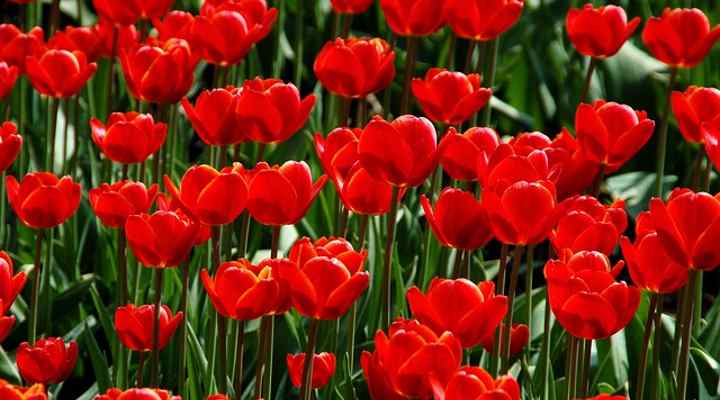
In Hanakotoba, red tulips (Akiachurippu) may be used to symbolize love and passion. Wishing someone success with red tulips is also a lovely gesture. Red tulips are linked to real love and unyielding passion in many civilizations. Bulbous plants that bloom in the springtime are known as tulips.
Tulips come in over 3,000 types, with flower form and color differences on almost every tulip. The cup-shaped blossom with rounded petals is the traditional tulip blossom shape. Tulips may alternatively have lily-like blooms with pointed petals, a double bowl-shaped bloom, or even blooms.
Sumire – Violet (Viola)

In Japanese culture, the beautiful violet flowers represent sincerity, love, and joy. You may express this with delicate violet violets. In zone 2, a few violet species are hardy, but in zones 4 through 9, most violets produce. Violets grow as annuals or perennials, depending on the climate and species.
Violets come in a variety of colors and patterns, each with its own markings. In addition, Viola species have some of the most beautiful color combinations you’ll see on a flower. Purple, orange, light pink, golden yellow, and white are some of the different violets. Petals with contrasting color combinations, such as dark purple and brilliant orange, can be found in some striking violets.
Rabenda – Lavender (Lavandula)

The lavender is an appropriate flower because it represents fidelity in Hanakotoba. Lavender fields are a popular sight in Japan in the summer, despite the fact that it is associated with the Mediterranean. Lavender is well-known in Japan, and it’s a island off the coast of Hokkaido.
In Japan, fields of purple, yellow, and red lavender are stunning to see. Lavender plants are tiny, tough shrubs that bloom in the summer with flowers that are purple and fragrant. As foundation plants, sunny flower beds, and containers, lavender is suited for growing along herbaceous borders.
